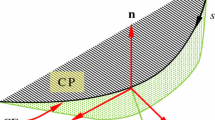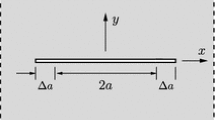Abstract
The potential fracture configurations of a cracked solid under mixed Mode-I/III loading are investigated based on a three-dimensional energy-based model, which can effectively capture the physical process of energy release induced by multiple cracks initiation from a crack tip. In order to maximize the energy release rate, four integral subintervals for Ji-integral around a crack tip have been suggested, based on which the four concerned energy-based driving forces have been identified. In this regard, when the driving forces reach the critical value, the concerned local boundaries around a crack tip will fracture, respectively, in a form of either wing cracks or crack extension. A series of potential fracture configurations for cracked solids under the mixed Mode-I/III loading, such as the crack tri-branching, symmetrical branching, side-branching, kinking and extension, can be theoretically predicted from the combination of the triggered new cracks. Some understanding on the fracture mechanism in engineering and experimental research should be refreshed based on the present theoretical investigations. Typical fracture configurations and concerned K-based effective fracture toughness predicted by the present modelling and Griffith’s criterion agree well with the experimental results in the available literature.
















Similar content being viewed by others
Abbreviations
- \(\alpha_{i}\), \(\alpha_{ic}\) :
-
Angle between the shifting direction of the local boundary and \(x_{i}\)-axis and its critical value
- \(\alpha\) :
-
Inclined angle of the crack plane relative to the loading roller
- \(r, \, \theta\) :
-
Polar coordinates
- \(\varphi\) :
-
Normalized parameter
- \(\mu\) :
-
Poisson’s ratio
- \(\sigma_{ij}\) :
-
Stress components
- \(A,A_{i}\), \(s,s_{i}\) :
-
Boundary surfaces or integration paths around the crack tip
- E :
-
Young's modulus
- G :
-
Energy release rate for boundary shifting
- \(G^{{{\text{tri}} - b}}\), \(G_{\max }^{tri - b}\), \(G_{C}^{{{\text{tri}} - b}}\) :
-
Energy release rate, its maximum and critical value for crack tri-branching
- \(G_{\max }^{{{\text{side}} - b}}\), \(G_{\max }^{{{\text{sym}} - b}}\), \(G_{\max }^{{{\text{kinking}}}}\) :
-
Energy-based configuration driving forces for crack side-branching, symmetrical-branching and kinking, respectively
- \(G_{\max }^{{A - {\text{ext}}}}\) :
-
Energy-based driving force for boundary A moving in x1-direction in a form of crack extension
- \(G_{\max }^{{A - {\text{wing}}}}\) :
-
Energy-based driving force for boundary A moving as a wing crack
- \(J_{i}\) :
-
Conservation integrals
- \(K_{{{\text{eff}} - C}}^{{{\text{tri}} - b}}\), \(K_{{{\text{eff - }}C}}^{{{\text{side}} - b}}\), \(K_{{{\text{eff}} - C}}^{{{\text{sym}} - b}}\) :
-
K-based effective fracture toughness for crack tri-branching, side-branching and symmetrical-branching, respectively
- \(K_{{{\text{eff}} - C}}^{{A - {\text{wing}}}}\), \(K_{{{\text{eff}} - C}}^{{A - {\text{ext}}}}\) :
-
K-based effective fracture toughness for local boundary A moving as a wing crack or crack extension
- \(K_{{{\text{IC}}}}\) :
-
Fracture toughness for pure Mode-I crack extension
- \(K_{I}\), \(K_{III}\) :
-
Stress intensity factors for the Mode-I or Mode-III deformations
- P :
-
Load
- \(r_{o}\) :
-
Polar coordinate of the boundary surface around crack tip
- \(T_{i}\) :
-
Stress vector acting on the integration surface or path
- \(u_{i}\) :
-
Displacement components
- \(v_{i}\) :
-
Direction of the local boundary \(A_{i}\) shifting
- w :
-
Strain energy density
References
Aliha, M.R.M., Ayatollahi, M.R.: Analysis of fracture initiation angle in some cracked ceramics using the generalized maximum tangential stress criterion. Int. J. Solids Struct. 49, 1877–1883 (2012)
Erdogan, F., Sih, G.C.: On the crack extension in plates under plane loading and transverse shear. J. Basic Eng. Trans ASME. 85, 519–525 (1963)
Sih, G.C.: Strain-energy-density factor applied to mixed Mode crack problems. Int. J. Fract. 10, 305–321 (1974)
M. A. Hussain, S. L. Pu, J. Underwood.: (1974) Strain energy release rate for a crack under combined Mode I and Mode II. Fracture Analysis,. ASTM STP 560. American Society for Testing and Materials, Philadelphia, pp. 2–28.
Akbardoost, J., Ayatollahi, M.R., Aliha, M.R.M., Pavier, M.J., Smith, D.J.: Size-dependent fracture behavior of Guiting limestone under mixed Mode loading. Int. J. Rock Mech. Min. Sci. 71, 369–380 (2014)
Aliha, M.R.M., Hosseinpour, Gh.R., Ayatollahi, M.R.: Application of cracked triangular specimen subjected to three-point bending for investigating fracture behavior of rock materials. Rock Mech. Rock Eng. 46, 1023–1034 (2013)
Mirsayar, M.M., Razmi, A., Aliha, M.R.M., Berto, F.: EMTSN criterion for evaluating mixed mode I/II crack propagation in rock materials. Eng. Fract. Mech. 190, 186–197 (2018)
Aliha, M.R.M., Berto, F., Mousavi, A., Razavi, S.M.J.: On the applicability of ASED criterion for predicting mixed mode I+II fracture toughness results of a rock material. Theor. Appl. Fract. Mech. 92, 198–204 (2017)
Razavi, S.M.J., Aliha, M.R.M., Berto, F.: Application of an average strain energy density criterion to obtain the mixed mode fracture load of granite rock tested with the cracked asymmetric four-point bend specimens. Theor. Appl. Fract. Mech. 97, 419–425 (2018)
Cotterell, B., Rice, J.R.: Slightly curved or kinked cracks. Int. J. Fract. 16, 155–169 (1980)
Lin, B., Mear, M.E., Ravi-Chandar, K.: Criterion for initiation of cracks under mixed-mode I+III loading. Int J Fract. 165, 175–188 (2010)
Pons, A.J., Karma, A.: Helical crack-front instability in mixed-mode fracture. Nature 464, 85–89 (2010)
Chen, C.H., Cambonie, T., Lazarus, V., Nicoli, M., Pons, A.J., Karma, A.: Crack front segmentation and facet coarsening in mixed-mode fracture. Phys. Rev. Lett. 115, 265503 (2015)
Pollard, D.D., Segall, P., Delaney, P.T.: Formation and interpretation of dilatant echelon cracks. Geol. Soc. Am. Bull. 93, 1291–1303 (1982)
Karma, A., Kessler, D.A., Levine, H.: Phase-field model of mode III dynamic fracture. Phys. Rev. Lett. 87, 045501 (2001)
Hakim, V., Karma, A.: Crack path prediction in anisotropic brittle materials. Phys. Rev. Lett. 95, 235501 (2005)
Hakim, V., Karma, A.: Laws of crack motion and phase-field models of fracture. J. Mech. Phys. Solids 57, 342–368 (2009)
Meggiolaro, M.A., Miranda, A.C.O.: Stress intensity factor equations for branched crack growth. Eng. Fract. Mech. 72, 2647–2671 (2005)
Li, X.H., Zheng, X.Y., Yuan, W.J., Cui, X.W., Xie, Y.J., Wang, Y.: Instability of cracks initiation from a mixed-mode crack tip with iso-stress intensity factors KI and KII. Theor. Appl. Fract. Mech. 96, 262–271 (2018)
Xie, Y.J., Li, J., Hu, X.Z., Wang, X.H., Cai, Y.M., Wang, W.: Modelling of multiple crack-branching from Mode-I crack-tip in isotropic solids. Eng. Fract. Mech. 109, 105–116 (2013)
Xie, Y.J., Duo, Y.L., Yuan, H.: Potential fracture paths for cracked rocks under compressive-shear loading. Int. J. Rock Mech. Min. Sci. 128, 104216 (2020)
Yuan, H., Xie, Y.J., Wang, W.: Underlying fracture trends on mode-I crack multiple-branching. Eng. Fract. Mech. 225, 106835 (2020)
Li, J., Xie, Y.J., Zheng, X.Y., Cai, Y.M.: Underlying fracture trends and triggering on Mode-II crack branching and kinking for quasi-brittle solids. Eng. Fract. Mech. 211, 382–400 (2019)
Eshelby, J.D.: The force on an elastic singularity. Phil Trans. Roy. Soc. London Ser A. 244, 87–112 (1951)
Budiansky, B., Rice, J.R.: Conservation laws and energy-release rates. ASME J. Appl. Mech. 40, 201–203 (1973)
Griffith, A.A.: The phenomena of rupture and flow in solids. Phil. Trans. Roy. Soc. Lon. Ser. A. 221, 163–198 (1921)
Cherepanov, G.P.: Mechanics of brittle fracture, Moscow, Publish House “Nuaka”, 1974, pp. 266–269. English translation published by McGraw-Hill International Book Co., New York (1979)
Yuan, H., Xie, Y.J.: Disturbance effects of weak Mode-II loading on K-based Mode-I fracture toughness test. Theor. Appl. Fract. Mech. 110, 102822 (2020)
Yoffe, E.: The moving griffith crack. Phil. Mag. 42, 739–750 (1951)
Ravi-Chandar, K., Knauss, W.G.: An experimental investigation into dynamic fracture: III. On steady-state crack propagation and crack branching. Int. J. Fract. 26, 141–154 (1984)
Aliha, M.R.M., Bahmani, A., Akhondi, Sh.: Numerical analysis of a new mixed mode I/III fracture test Specimen. Eng. Fract. Mech. 134, 95–110 (2015)
Aliha, M.R.M., Linul, E., Bahmani, A., Marsavina, L.: Experimental and theoretical fracture toughness investigation of PUR foams under mixed mode I+III loading. Polym. Testing 67, 75–83 (2018)
Aliha, M.R.M., Bahmani, A., Akhondi, Sh.: A novel test specimen for investigating the mixed mode I + III fracture toughness of hot mix asphalt composites–experimental and theoretical study. Int. J. Solids Struct. 90, 167–177 (2016)
Aliha, M.R.M., Berto, F., Bahani, A., Akhondi, Sh., Barnoush, A.: Fracture assessment of polymethyl methacrylate using sharp notched disc bend specimens under mixed mode I+III loading. Phys. Mesomech. 19, 355–364 (2016)
Aliha, M.R.M., Bahmani, A., Akhondi, Sh.: Determination of mode III fracture toughness for different materials using a new designed test configuration. Mater. Des. 86, 863–871 (2015)
Aliha, M.R.M., Bahmani, A.: Rock fracture toughness study under mixed mode I/III loading. Rock Mech. Rock Eng. 50, 1739–1751 (2017)
Hu, X.: Additive effect of micro-damage zones from nano-scale crack tip and nano-grains for fracture toughness measurements of 3Y-TZP zirconia. J. Eur. Ceram. Soc. 42(15), 7174–7179 (2022)
Acknowledgements
This work was supported by National Natural Science Foundation of China (Grant Nos.: 50771052, 50971068 and 11272141) and Natural Science Foundation of Liaoning (Grant Nos.: LS2010100 and 20102129).
Author information
Authors and Affiliations
Corresponding author
Additional information
Publisher's Note
Springer Nature remains neutral with regard to jurisdictional claims in published maps and institutional affiliations.
Rights and permissions
Springer Nature or its licensor (e.g. a society or other partner) holds exclusive rights to this article under a publishing agreement with the author(s) or other rightsholder(s); author self-archiving of the accepted manuscript version of this article is solely governed by the terms of such publishing agreement and applicable law.
About this article
Cite this article
Wang, L., Xie, Y.J. & Yuan, H. Potential fracture configurations of a cracked solid under mixed mode-I/III loading. Arch Appl Mech 93, 2033–2049 (2023). https://doi.org/10.1007/s00419-023-02371-x
Received:
Accepted:
Published:
Issue Date:
DOI: https://doi.org/10.1007/s00419-023-02371-x




